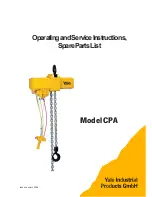
9
6.3 LOAD CHAIN
The Yale load chain is quality class 8 chain with the meas-
urements 11 x 13. Yale electric hoists are specially designed
to use this type of chain. For this reason only chains that
have been approved by the manufacturer may be used in
these hoists.
Lubricating the load chain
The load chain is to be lubricated before initial operation
and every 3 months but at the latest after 200 operating hours.
Adverse working conditions, e.g. excessive dust or contin-
ued heavy duty can dictate shorter periods between lubrica-
tion.
Before the chain is lubricated it must be cleaned. Flame-
cleaning is forbidden. Use only cleansing methods and
agents that do not corrode the chain material. Avoid cleans-
ing methods that can lead to hydrogen brittleness, e.g. spray-
ing or dipping chain in caustic solvents. Also avoid surface
treatments that can hide cracks and flaws or other surface
damage.
The chain must be lubricated in a no-load condition so that
lubricant can enter between the links, e.g. by dipping in oil.
The whole chain must be lubricated.
Motor oil of the viscosity class 100, e.g. Shell Tonna T68 can
be used to lubricate the chain. For very dusty applications
use a dry lubricant.
Inspecting the load chain for wear
Load chains must be inspected every three months or at the
latest after 200 operating hours (see VBG8 § 27 or local
specifications).
Visually inspect the chain over its full length for deformation,
cracks, flaws, elongation, wear or corrosive pitting.
Link chains must be replaced when the nominal thickness
“d” on any part of the chain has been reduced by more than
10% (see fig. 4) or when the partition “t” is elongated by
more than 2% or over 11 partitions (11 x t) by 2%. Nominal
dimensions and wear limits are shown in following table.
Chains that do not fulfil all requirements must be replaced
immediately.
Replace the load chain
Single-fall design
1.) Disassemble lower block
Remove the circlip with suitable pliers. Raise the swivel
tube in the direction of the chain and tap out the chain pin
with a drift.
Attention:
Do not damage the chain pin bore.
2.) Remove the chain stop
Remove the 2 screws and remove the chain stop. The chain
is now free.
3.) Fitting the new chain
Cut the second to last link open on the loose end of the
load chain to form a “C”. Remove the last link and connect
the new chain. The new chain must be fitted so that the
welds on the standing links face towards the chain guide
and away from the chain wheel. Operate the hoist in the
“lift” direction to feed the new chain through the hoist.
4.) Fitting lower block and chain stop
Slide the end buffers over the chain ends and refit lower
block and chain stop. The chain stop must be fitted so that
at least 1 link remains free (see fig. 1).
5.) Before initial operation lubricate the unloaded chain and
test all hoist functions under a no-load condition
Two-fall design.
1.) Remove the chain anchor pin
The chain anchor pin is situated on the underside of the
hoist body. With an Allen key remove the grub screw that
serves as the locking device. Tap out the chain anchor pin
from the other side with a drift.
Attention:
Do not damage anchor pin or bore.
2.) Pull the load chain through the lower block and remove
the chain stop.
3.) Fitting the new chain
Cut the second to last link open on the loose end of the
load chain to form a “C”. Remove the last link and connect
the new chain. The new chain must be fitted so that the
welds on the standing links face towards the chain guide
and away from the chain wheel. Operate the hoist in the
“lower” direction to feed the new chain through the hoist.
4.) Replace chain stop
Slide the buffer pad over the loose end of the load chain
and refit chain stop ensuring that at least one link remains
free (see fig. 1).
5.) Fitting the chain anchor pin
Inspect the chain anchor pin for flaws, cracks or burrs.
Thread the load chain, ensuring it is not twisted, through
the lower block. Enter the last link of the load chain into the
slot in the underside of the hoist body and enter the anchor
pin through the side bore. Move the last link back and forth
while entering the anchor pin to ensure that it is not trapped
and damaged by the anchor pin. Secure the chain anchor
pin with the grub screw.
6.) Assemble the lower block
Check the chain wheel for damage. Grease the needle bear-
ings in the lower block halves. Place the load hook and the
buffer in the slots provided in one lower block half. Wrap the
load chain around the chain wheel ensuring that the chain is
not twisted and that the welds on the standing links face
away from the chain wheel. Engage the chain wheel, with
load chain, into the pre-assembled lower block half. Ensur-
ing that the buffer pad is situated correctly in its groove re-
place the second lower block half and secure with the screws.
d
1
+ d
2
2
<
=
d = nominal thickness of chain
d
1
, d
2
= Actual value
d
m
= 0,9 d
t
11 x t
d
1
d
2
Link chain 11 x 31 min. quality class 8
Inspection Dim.
Nominal value
[mm]
Limit value
[mm]
Elongation over 11 partitions
11 • t
341
347
Elongation over 1 partition
t
31
32
Average link thickness
d
1
+d
2
2
11,3 10,2
Содержание CPA Series
Страница 1: ...1 ModelCPA OperatingandServiceInstructions SparePartsList Issue January 2002...
Страница 18: ...18 Fig 19 Gearbox...
Страница 28: ...28 Fig 29 Air motor for trolley...





























